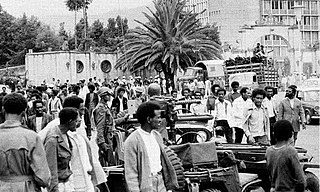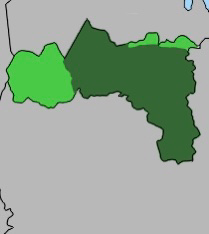
The politics of Eritrea and the government of Eritrea take place in the framework of a single-party presidential republican totalitarian dictatorship. The President officially serves as both head of state and head of government. The People's Front for Democracy and Justice is the only political party legally permitted to exist in Eritrea. The popularly elected National Assembly of 150 seats, formed in 1993 shortly after independence from Ethiopia, elected the current president, Isaias Afwerki. There have been no general elections since its official independence in 1993. A new constitution was drafted in 1993 and ratified in 1997, but has not been implemented. Since the National Assembly last met in January 2002, President Isaias Afwerki has exercised the powers of both the executive and legislative branches of government.

The foreign relations of Eritrea are the policies of the Eritrean government by which it administers its external relations with other nations. Since its independence, Eritrea's foreign relations have been dominated by conflict and confrontation, both in the regional and international arenas. It has maintained often troubled, and usually violent, relations with its neighbors, including brief armed conflicts with Yemen and Djibouti and a destructive war with its bigger-neighbour, Ethiopia. At present, Eritrea has very tense relations with neighboring Ethiopia and Djibouti. Relations in the international arena also have been strained since the last decade, particularly with major powers. What appeared cordial relations with the US in the 1990s turned acrimonious following the border war with Ethiopia, 1998-2000. Although the two nations have a close working relationship regarding the ongoing war on terror, there has been a growing tension in other areas. Ties with international organizations such as the United Nations, the African Union, and the European Union have also been complicated in part because of Eritrea's outrage at their reluctance to force Ethiopia to accept a boundary commission ruling issued in 2002.

A widespread famine affected Ethiopia from 1983 to 1985. The worst famine to hit the country in a century, it affected 7.75 million people and left approximately 300,000 to 1.2 million dead. 2.5 million people were internally displaced whereas 400,000 refugees left Ethiopia. Almost 200,000 children were orphaned.

Isaias Afwerki is an Eritrean politician and partisan who has been the president of Eritrea since shortly after he led the Eritrean People's Liberation Front (EPLF) to victory on 24 May 1991, ending the 30-year-old war for independence from Ethiopia. In addition to being president, Isaias has been the chairman of Eritrea's sole legal political party, the People's Front for Democracy and Justice (PFDJ). As Eritrea has never had a functioning constitution, no elections, no legislature and no published budget, Isaias has been the sole power in the country, controlling its judiciary and military. Hence, scholars and historians have long considered him to be a dictator, described his regime as totalitarian, by way of forced conscription; the United Nations and Amnesty International cited him for human rights violations. In 2022, Reporters Without Borders ranked Eritrea, under the government of Isaias, last out of 180 countries in its Press Freedom Index. In 2023 Eritrea ranked 174th out of 180 countries on the Press Freedom Index.

The Derg, officially the Provisional Military Administrative Council (PMAC), was the Marxist–Leninist military dictatorship that ruled Ethiopia, then including present-day Eritrea, from 1974 to 1987, when the military leadership or junta formally "civilianized" the administration but stayed in power until 1991.

The Second Sudanese Civil War was a conflict from 1983 to 2005 between the central Sudanese government and the Sudan People's Liberation Army. It was largely a continuation of the First Sudanese Civil War of 1955 to 1972. Although it originated in southern Sudan, the civil war spread to the Nuba mountains and the Blue Nile. It lasted for almost 22 years and is one of the longest civil wars on record. The war resulted in the independence of South Sudan 6 years after the war ended.

The Eritrean People's Liberation Front (EPLF), colloquially known as Shabia or HGDEF, was an armed Marxist–Leninist organization that fought for the independence of Eritrea from Ethiopia. It emerged in 1973 as a far-left to left-wing nationalist group that split from the Eritrean Liberation Front (ELF). After achieving Eritrean independence in 1991, it transformed into the People's Front for Democracy and Justice (PFDJ), which serves as Eritrea's sole legal political party.

The Eritrean–Ethiopian War, also known as the Badme War, was a major armed conflict between Ethiopia and Eritrea that took place from May 1998 to June 2000.

The Eritrean War of Independence was a war for independence which Eritrean independence fighters waged against successive Ethiopian governments from 1 September 1961 to 24 May 1991.

The Ethiopian Civil War was a civil war in Ethiopia and present-day Eritrea, fought between the Ethiopian military junta known as the Derg and Ethiopian-Eritrean anti-government rebels from 12 September 1974 to 28 May 1991.
Alexander William Lowndes de Waal, a British researcher on African elite politics, is the executive director of the World Peace Foundation at the Fletcher School of Law and Diplomacy at Tufts University. Previously, he was a fellow of the Harvard Humanitarian Initiative at Harvard University, as well as program director at the Social Science Research Council on AIDS in New York City.
Articles related to Ethiopia include:

The military history of Ethiopia dates back to the foundation of early Ethiopian Kingdoms in 980 BC. Ethiopia has been involved in many of the major conflicts in the horn of Africa, and was one of the few native African nations which remained independent during the Scramble for Africa, managing to create a modern army. 19th and 20th century Ethiopian Military history is characterized by conflicts with the Dervish State, Mahdist Sudan, Egypt, and Italy, and later by a civil war.
The Eritrean Army is the main branch of the Eritrean Defence Forces and is one of the largest armies in Africa. The main role of the army in Eritrea is defense from external aggressors, border security, and developing national cohesion. Historically, the predecessor of the Eritrean Army, the Eritrean People's Liberation Front (EPLF), played a major role in establishing and defending the country's independence from Ethiopia in 1991 during the Eritrean War of Independence. Since then, the army has continued to be involved in low-level border conflicts with Ethiopia and several other neighbors, including Djibouti and Yemen, with the most notable one being the Ethiopian-Eritrean War from 1998 until 2000, which ended in a partial Ethiopian military victory and Eritrean boundary line victory. It is widely regarded as one of the largest and more capable armies in Africa, despite the country having a smaller population than most of its neighbors with around 250,000 to 300,000 personnel due to mandatory national service. Conscription became open ended since the war with Ethiopia and no demobilization has taken place.

The Eritrean Civil Wars were two conflicts that were fought between competing organizations for the liberation of Eritrea.

John Prendergast is an American human rights and anti-corruption activist as well as an author. He is the co-founder of The Sentry, an investigative and policy organization that seeks to disable multinational predatory networks that benefit from violent conflict, repression, and kleptocracy. Prendergast was the founding director of the Enough Project and was formerly director for African affairs at the National Security Council.

Corruption in Eritrea is considered a deeply serious and growing problem. The level of corruption used to be considerably lower in Eritrea than in many other African countries. Indeed, it was traditionally viewed as having a “strong ‘anti-corruption’ culture” and considered relatively “egalitarian and corruption-free.” In 2006, a report by Bertelsmann Stiftung stated that corruption, as of that date, was not a serious problem within Eritrea. While noting that there had been “cases of corruption since independence,” they existed on a negligible level, although politically-motivated corruption allegations have been made. But, in fact, corruption is said to have been growing steadily worse ever since 1998, when, not long after the end of its decades-long war of independence, a border conflict with Ethiopia led to another war.

The Tigray Defense Forces, colloquially called the Tigray Army is a paramilitary group located in the Tigray region of Ethiopia. It was founded by former generals of the Ethiopian Military in 2020 to combat federal forces enforcing national government mandates in the Tigray region, culminating in 2020 with the outbreak of the Tigray War. The TDF has made use of guerilla tactics and strategies. Human rights groups including Amnesty International and Human Rights Watch have reported that the TDF has committed war crimes against civilians including gang rape and extrajudicial killing during their occupation of both the Afar and Amhara regions. According to the Ethiopian Ministry of Justice, TDF combatants have been found liable for upwards of 540 civilians casualties. as of 28 December 2021.

This is a chronology of the lifetime of Ethiopian Emperor Haile Selassie.

The Eritrea–Sudan border is 686 km (426 mi) in length and runs from Eritrea and Sudan's tripoint with Ethiopia in the south, to the town of Ras Kasar in the very south of Eritrea. The border has been the site of several tensions, with deportations, border conflicts and colonialism by the United Kingdom and Italy. The border has also seen illegal acts such as human trafficking and hundreds of illegal crossings made by Eritreans. Due to the Tigray War, Sudan saw a surge of Eritrean and Ethiopian civilians cross its border with Eritrea and by 2023 there were nearly 130,000 refugees and civilians confirmed living in the country.















